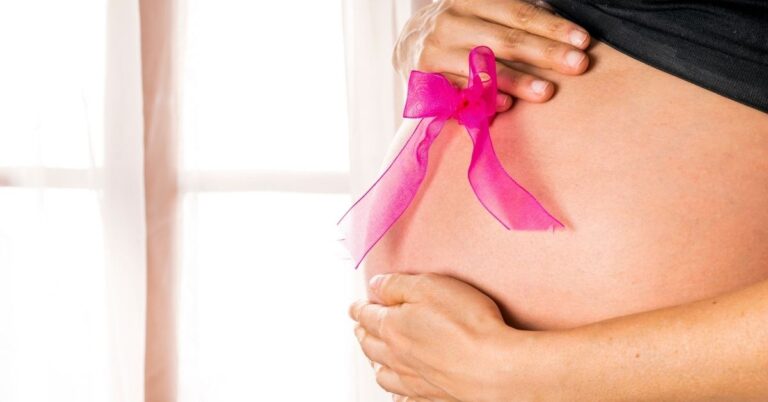It’s no secret that pregnancy causes many changes to your body and I know I was surprised when I first noticed how much my breasts had changed! Everyone seems to know that you get bigger breasts when you’re pregnant, but I certainly was shocked when I first saw my breasts producing liquid so soon. Luckily, I covered everything you need to know about is it bad to squeeze your breasts during pregnancy and what to expect from them!

So, Is it Bad to Squeeze Your Breast During Pregnancy?
You may be wondering is it bad to squeeze your breast during pregnancy? Well, no, It’s not bad to squeeze breast during pregnancy, and from around 36 weeks of pregnancy as it is recommended that you do squeeze your breasts. The squeezing can help assist your body to go into labor and it is also a great way to collect some of the nutrient-rich colostrum your baby will need.
Benefits of Squeezing Your Breasts During Pregnancy
Squeezing your breasts during pregnancy can have a number of benefits. It can help to stimulate milk production, increase blood flow to the area, and also help to relieve some of the discomforts that can come with pregnancy. Here are the 3 main benefits of squeezing your breasts during pregnancy:
1) Stimulate Milk Production: As your baby grows, its demand for milk will increase. One way to help keep up with this demand is to stimulate your milk production by gently massaging and squeezing your breasts. This can also help to prevent engorgement later on.
2) Increase Blood Flow to the Area: Gently massaging and squeezing your breasts can also help to increase blood flow to the area. It can help to keep your breasts healthy and can also help to ease some of the discomforts that can come with pregnancy.
3) Relieve Some of the Discomforts: Some of the discomforts that can come with pregnancy include engorgement, blocked ducts, and mastitis. Gently massaging and squeezing your breasts can help to relieve some of these discomforts.
How Do You Squeeze Your Breasts During Pregnancy Correctly
When squeezing your breasts during pregnancy, it is important to do so correctly in order to get the most benefit possible. Make sure that you use both hands and apply gentle pressure. Be careful not to squeeze too hard or you could cause discomfort. Here is the step-by-step process:
1. Start by Cupping Your Breasts With Your Hands: First, use both hands to cup your breasts. You can do this by placing your palms on each side of your breasts and then gently pressing in.
2. Apply Gentle Pressure and Massage in a Circular Motion: Once your breasts are cupped, apply gentle pressure and massage in a circular motion. Do this for several seconds. Then, release the pressure and massage in the opposite direction.
3. Repeat This Process for Several Minutes: Repeat this process of applying pressure and massaging for several minutes. You can do this as often as you like, but it is generally recommended to do it at least once per day.
When Is It Safe To Start Squeezing Breasts During Pregnancy?
We often hear that nipple stimulation is suggested to get your labor started, but when is it safe to do so without the risk of complications?
Hormonal and physical changes during pregnancy prepare your boobs so you can feed your newborn straight away, but if you interfere too much too soon then this can cause premature labor which poses health risks for both mum and baby.
The advice will change depending on each woman’s health and circumstances, but the earliest recommended time to start squeezing breasts during pregnancy is when you have reached full-term pregnancy at 39 weeks and onwards.
Many women find pumping and storing breastmilk before their baby is born helps to relieve some of the heaviness they feel, but generally, it is not completely necessary to pump before birth to guarantee a successful breastfeeding journey.
Harvesting colostrum in the syringes provided by your medical advisor is also safe to do from 38-39 weeks onwards as this means you have a handy stash of this liquid gold available in case you or your baby have any problems. Colostrum is rich in antioxidants and antibodies to build your little ones’ immune system so it’s massively beneficial when they are firstborn.
Are There Any Risks With Squeezing Breasts During Pregnancy?
There are no risks associated with squeezing your breasts during pregnancy as long as you do so gently and correctly. Doing it gently, there should be no problem. Keep in mind the following things:
1. Don’t squeeze your breasts too hard.
2. Be careful not to cause yourself discomfort.

Why Do I Get Clear Liquid Coming Out of Breast When Squeezed in Early Pregnancy?
During my first trimester, I was mainly focused on trying to not throw up constantly, and with so many big changes going on it’s easy to see why pregnancy leaves us feeling so tired and drained.
Your body starts to produce colostrum for your sweet baby from the first trimester which means you can get clear liquid coming out of your breast when squeezed even in early pregnancy. This is due to the prolactin hormone that is responsible for producing milk for your baby and it will start to increase ready for your due date.
Doctors and midwives generally recommend that most mothers perform nipple stimulation as a way to help their bodies go into labor naturally and avoid the need for any interventions, but if you are still in the early stages of pregnancy you may want to hold back on squeezing your boobs too much.
Nipple stimulation causes the release of an amazing hormone known as Oxytocin, or “the love hormone” which will also cause your body to start contracting so your cervix opens up to get your labor into full swing. Although nipple stimulation alone isn’t likely to start your labor if you’re in early pregnancy, you should keep in mind that as your breasts tend to swell up and feel sore it’s best to not squeeze them excessively.
How To Harvest Colostrum
Your healthcare provider may not recommend colostrum harvesting if you have a history of pregnancy complications or premature labor as it could cause your body to go into labor before it’s ready and create health risks in your pregnancy.
If you are having a c-section, multiple babies, or an induction then you may find harvesting colostrum is a good idea for you as it can help you learn about hand expression too.
Ask your healthcare provider if they offer feeding syringes as they are perfect to use for storing and easy feeding with your little one.
- You may find it easier to express your colostrum into a clean, sterile container and then harvest it into the syringes as hand expression is easier with two free hands.
- A great way to relax your body and harvest your colostrum easily is by having a warm bath or shower beforehand to promote the letdown of your colostrum.
- Once you’re ready, massage your breast tissue from the top and sides and work down towards your nipple to encourage the flow and letdown reflex in your breast.
- Hold your fingers and thumb around the breast in a C-shape (imagine you’re squeezing a burger to eat!) and keep your fingers around 1-2 inches around your nipple area. Then squeeze your fingers and thumb together.
- Keep doing this until your breast releases colostrum, but don’t expect lots as it is common to only get a few drops at a time.
- If your breasts feel sore or uncomfortable at any time then don’t continue as this will likely only become more painful for you
- Once your flow has stopped, switch breasts and repeat before storing the syringes in the freezer in 1 to 2 milliliters amounts. Pop them into zip-top bags and write the date you expressed them for easy storage.
Squeezing Breast During Pregnancy – FAQs (click to expand each)
How often should you squeeze your breasts during pregnancy
You can squeeze your breasts as often as you like during pregnancy. However, it is typically recommended that you do so at least once a day in order to stimulate milk production.
Can you continue to squeeze your breasts after giving birth?
Yes, you can continue to squeeze your breasts after giving birth. It will help to stimulate milk production and provide relief from engorgement. When doing so, make sure to use gentle pressure and massage in a circular motion. I remember when my daughter was born, my breasts were so engorged and painful. Hand expressing or using a breast pump helped to relieve some of the discomforts.
When should I start harvesting colostrum?
Harvesting colostrum isn’t essential, but if you do choose to then you can start from 38 weeks of pregnancy for a few minutes a day. Some women notice they leak from as early as 16 weeks pregnant, this is normal.
Can squeezing nipples induce labor?
Nipple squeezing and stimulation can induce labor by releasing chemicals such as Oxytocin to cause uterine contractions and bring on labor.
What foods help produce breast milk?
Although many foods and recipes claim to increase breast milk production, in truth you need to make sure your diet contains a good range of essential vitamins and minerals such as fatty acids and omega-3 so your body can produce this milk.
Is it bad to express colostrum while pregnant?
For some women, it is not recommended to express colostrum whilst pregnant as it can cause premature labor so you should always ask for advice from your healthcare provider before you start to express colostrum.
Wrapping Up
So is it bad to squeeze your breast during pregnancy – Actually it is not only not bad but can actually be beneficial to both mom and baby.
Many women are scared of squeezing their breasts during pregnancy as there is the dread of it causing premature labor, although this is extremely rare. But harvesting colostrum before your baby is born is not necessary and in most cases, you will only see benefits from it if you have a planned c-section or are being induced.
So there is no need to worry if you find squeezing your breasts uncomfortable or even painful, you can just stop and let nature do her thing!!!
More to Read: